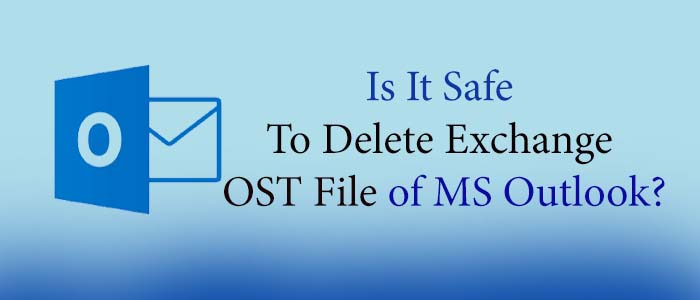Yes, you can delete OST files but there are a few precautions to take before deleting these files. Your Microsoft Exchange profile must be active and in good health. Some other steps we have to consider. Let’s find out the precautions to follow.
“Our organization uses MS Exchange Server for management of emails. We manage more than one account. Sometimes, we also perform exchange of databases. Therefore, we want to know “Is it safe to delete OST files?” What will happen if I delete an OST file.”
Offline Storage Table or OST is a common file format of MS Outlook for Windows when you integrate Exchange Server with Outlook. The file format contains emails, contacts, notes, messages, journals, and many other properties. In this article, we will learn the methods that helps to delete .ost files without losing email messages.
Outlook Offline Storage Table File (OST)
- Who doesn’t know about OST or Offline Storage Table? Outlook creates copy of the Exchange data to a local address in OST file format. OST files allow users to work offline and help manage the workflow. It lets users to access stored email messages, calendars, and much more without an internet connection.
- Office 365, Exchange accounts, and Outlook.com use an Offline Outlook Data File (or .ost) file. With offline work facility, OST files automatically synchronize with MS Outlook account when users work offline or make any changes in the offline folder.
- OST files are basically device specific and specific to the Exchange Server account. If you have changed your device or the Exchange account seems inaccessible, you cannot access OST files.
Reasons for Deleting Outlook OST Files
- There are various reasons that lead to deletion of OST files. One of the most common reasons for deleting OST filed is Synchronization errors. In these cases, Outlook performs abnormally and unable to give results. You can fix the issue by deleting the local copy of Outlook i.e., OST files. Here, users have doubts whether it is safe to delete OST files.
- Do you know space issue on your system can also provoke you to delete older OST files? OST files are large enough. They can be 20 GB to up to 50 GB. If the file size becomes oversized, it can become inaccessible. It can affect the function of Outlook. The application may stop working. In these cases, the
- If you delete an OST file, the chances are that you can get back the file data with configuration with Exchange Server. In case OST files are inaccessible, recovery of OST files is essential. Here you can take help of a third-party application like TrustVare OST Converter.
Deleting Outlook OST Files Safely
If you have made your mind to delete an OST file and want to avoid data loss issue, it is good to create backup of the file. In other words, you can plan OST to PST conversion. Exchange Server stores your Outlook databases, but it doesn’t hold the current emails. There are chances of losing important emails, contacts, and other properties. In the backup process, you can access your OST file data in another Windows system or another Outlook account. Here are the steps to follow to delete present Offline Storage Table or OST files.
- Turn off Outlook program if it is open.
- Navigate the Start menu and type Run in the search box. Copy and paste the below command in the Run Window to locate the offline data file location and press OK
![]()
- Select the desired OST file and right-click to hit the the Delete option. It will show the below message.
![]()
- Press Yes to complete the process.
This is the easy process to follow to delete an OST file from the system. After deleting the OST file, you can access Outlook. As the Exchange Server account configures with MS Outlook, the tool will automatically recreate an OST file. The following file may not have the current email communication and data if you have deleted the OST file because of synchronization issue. The new OST file has a new name with a different pathname. Now, you are ready to work with the new OST file.
Here are the steps to create a new Offline Storage Table.
After confirmation of deletion of the old OST file, you can work again. For confirmation, here are the steps you can follow.
- Close the Microsoft Outlook application
- Enter the New Name for the Existing OST File. Make sure the file name is unique.
- Now, Open the Outlook. An error message will appear.
![]()
- Press OK and in the Offline Folder File Settings dialog box, click OK again
Tip: In the OST Settings dialogue box, you can alter the file path and the file name.
- A message will Appear on the screen;
![]()
- Click Yes and navigate the Tools menu to click the Synchronize-All folders option
- This is the way you can synchronize the New OST File with the Exchange Server..
Concluding Lines
Can you delete an existing OST file? The answer is yes. You can delete the OST file if the file has any issues. Exchange Server can recreate the OST file. If you have orphaned OST files, you can transfer them to PST with the help of a professional utility.

